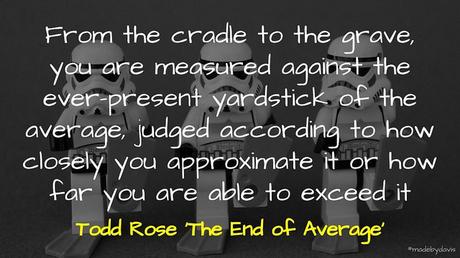In our Thinkibility nibble What Is An Interesting Book? we suggested that books with intellectual value should be categorized by the publisher into categories:
- Mainstream
- Improvement
- Criticism
- Provocation and Alternatives
We propose a strong candidate for category 4: Provocation and Alternatives: The End of Average: How We Succeed in a World That Values Sameness
- Subversive
- Dispels a myth
- For the aspiring nonconformist
- Provocative
- Overturns fundamental assumptions
- Transforms our understanding
Todd Rose: There are certain ideas, like this idea of the average person, that is so deeply ingrained in our society- everything from how we think about newborns and whether they're healthy, to the way we structure schools and workplaces.
Read again.
...everything from how we think about newborns and whether they're healthy, to the way we structure schools and workplaces.
Todd Rose: This whole idea of an average person happened in the mid-ninetieth century when countries were trying to figure out how to govern rapidly growing populations. There was no science of society, no social science. And it was a French astronomer named Adolphe Quetelet who came up with the idea. He basically asked himself, "If we were all astronomers and we were trying to measure the speed of Saturn, we would all get slightly different measurements, but which one is right?" It turns out, more or less, if you average together all the speeds, the average is usually the best estimate. In astronomy, that thinking turns out to be true most of the time. So by Quetelet's logic, he figured if the average is right in astronomy, we could stop worrying about the muddle of individual people and just average them out to make an average man. He actually coined the term "the average man". He believed this thinking to be so true that any deviation from average was a monstrosity.
So this became the foundation for bureaucracies, and then it slowly made its way into the rest of social science, and this thinking continues unabated today-in our education systems with GPAs and test scores, in our companies with performance reviews and hiring processes, in our healthcare system with the way we treat patients, and on and on.The provocativeness here is that the concept of Average as was developed in astronomy and later in physics was wrongly applied to groups of people. That is methodologically incorrect, as Peter Molenaar discovered in his study of ergodicity.
IQ tests, school careers, product design, syndrome and disease progression, market research, deviating mental states, ergonomy, personality tests, consumer behaviour, didactics and numerous other facts are based on a wrong assumption.
This applies in particular to training and education. Children are reduced to one-dimensional beings that meet the average in a range of subjects. Educational systems are not designed for blossoming students talents and skills, as Asa wrote in A Bit Average in her blog Sparking Children's Thinkibility.
The consequences of this paradigm shift in the humanities cannot be easily underestimated. What are the possibilities of abandoning the concept of Average? What does it mean for designing social systems? What does it means for all those algorithms that are developed in health care, crime prevention, taxes, surveillance......

